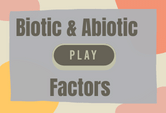Biotic and Abiotic Factors Game Quiz Online
Learn about ecosystems with this Biotic and Abiotic Factors Game Quiz Online for students in 5th, 6th, 7th, 8th grades. In an ecosystem, organisms are constantly interacting. These interactions are between living matter and nonliving matter. Both components of ecosystems are vital for their sustainance. Without any, ecosystems and their related food chains will fail to function. Examples of abiotic factors are water, carbon dioxide and soils. While examples of biotic elements are all living plant and animal matter in an ecosystem. Hence, plants need water and carbon diaoxide in the presence of sunlight to produce energy which serves other members of the ecosystem. Now think about the fact that if we take out one ingredient, there will be no photosynthesis and hence no food for other organisms. This game is a multiple choice test that can be used in the classroom and at home to study.

Biotic and abiotic factors affect the ability of organisms to survive and reproduce, the type of ecosystem in which they live, and their interactions with other organisms. Biotic factors, for example, affect disease, parasite infestations, predators, and the types of plants and animals that inhabit an area. Together, these factors form a biome and a biosphere. Both biotic and abiotic factors affect the types of plants and animals and are responsible for maintaining the environment.
Some biotic and abiotic factors in ecosystems
Biotic factors include all organisms in an ecosystem. They are divided into three groups: Producers, Consumers, and Decomposers. Producers create food by converting sunlight into organic compounds that contain carbohydrates and energy. Such creatures are called autotrophs. Detritivores, on the other hand, feed on abiotic factors. Detritivores, on the other hand, consume these products and decompose them.
Abiotic factors are not alive, but they can affect the growth of biotic factors. These include temperature, humidity, and water. The latter are essential for living organisms to thrive and survive. Some abiotic factors can even promote plant and animal growth. Winds can disperse seeds in the air, which helps with pollination. Winds can also affect humidity. Decomposers are vital to ecosystems.
In addition to decomposers, there are other abiotic factors in the environment. These are factors that break down organic material and return the simpler molecules to the soil. Detritivores include some plants and animals. Decomposers help recycle nutrients and reduce waste, and they are important members of an ecosystem.
Producers Converting Biotic and Abiotic Elements
Food is produced by organisms that use both biotic and abiotic factors. Biotic factors include interactions between living organisms, such as diseases, parasites, and competition between species. These factors also include producers, consumers, and decomposers. Producers are responsible for converting inorganic molecules into complex organic compounds. Plants, for example, use sunlight to produce energy for their growth and reproduction through photosynthesis. In this process, they release carbon dioxide and water, which is converted into food. On the other hand, bacterial species near hydrothermal vents use hydrogen sulfide as a food source.
The amount of sunlight, water, and soil are abiotic factors. Abiotic factors are physical, non-living components of an ecosystem. They affect the diversity of living organisms present. Without these elements, organisms would not be able to reproduce, grow, or survive. Without biotic and abiotic factors, however, there would be no food.
